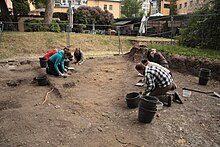
Back Δημόσια αρχαιολογία Greek Arqueología pública Spanish Avalik arheoloogia ET Yleisöarkeologia Finnish Arqueoloxía pública GL Arkeologi publik ID Arqueologia comunitária Portuguese

Community archaeology is archaeology by the people for the people.[editorializing] The field is also known as public archaeology. There is debate about whether the terms are interchangeable; some believe that community archaeology is but one form of public archaeology, which can include many other modes of practice, in addition to what is described here.[1] The design, goals, involved communities, and methods in community archaeology projects vary greatly, but there are two general aspects found in all community archaeology projects. First, community archaeology involves communities "in the planning and carrying out of research projects that are of direct interest to them".[2] Second, community archaeologists generally believe they are making an altruistic difference. Many scholars on the subject have argued that community collaboration does not have a pre-set method to follow.[3] Although not found in every project, there are a number of recurring purposes and goals in community archaeology. Similarities are also found in different countries and regions—due to commonalities in archaeological communities, laws, institutions, and types of communities. It has also been suggested that public archaeology can be defined in a broad sense as the production and consumption of archaeological "commodities".[4]